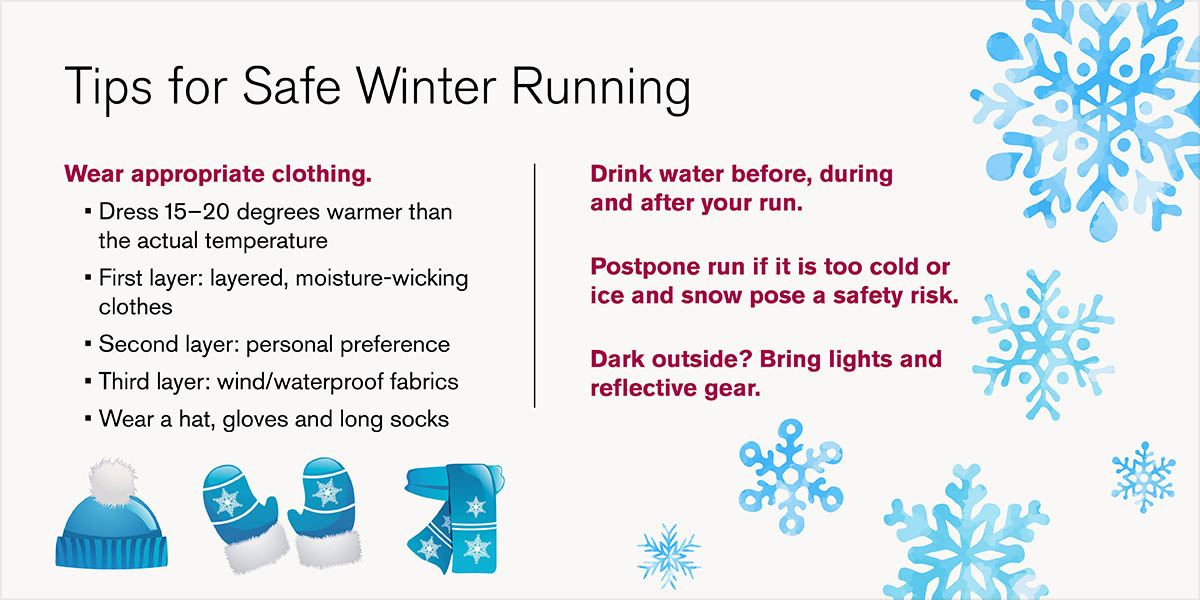Once winter comes, many runners switch to the treadmill or take a break from running until spring. However, with some preparation, you don't need to let the cold air stop you from keeping up with your fitness goals. Running in the winter is entirely possible. All it takes is understanding of how the cold air affects your body and joints. Also, learning how to stay warm will be the difference between an excellent winter run and a terrible one.
We spoke with Dr. Eliza Pierko, a sports medicine specialist at Loyola Medicine, about her tips for safe winter running. Dr. Pierko specializes in helping both fair-weather runners and winter running enthusiasts alike not only survive during a winter run, but thrive.

"Winter running is amazing to get away from the indoors and still be in nature, breathing that fresh, crisp air," says Dr. Pierko. "While precautions do need to be taken, like making sure you're dressing properly and avoiding black ice, it's a great way to exercise and break up your routine."
Is it safe to run in the cold?
There are unique risks to running in the winter. Ice and snow can increase the risk of falling and joint and ligament injuries. Also, the cold itself can cause bodily harm, such as frostbite, a condition where the skin and tissue are damaged by exposure to freezing temperatures, or simply numbness or pain in your nose and lungs.
Running in the cold can increase the risk of injury if a runner does not adequately prepare for these challenges. However, when a runner takes proper precautions, winter running can be a safe and enjoyable activity. In fact, some research has shown that the ideal running temperature is 44 degrees Fahrenheit.
There are two things you can do to ensure your safety while running in the cold. First, dress in appropriate clothing with enough layers. Second, don't run outside if the weather is too dangerous, whether there is too much ice or the temperature is too low.
"For most amateur runners, I do not recommend running outside when the temperature is below 0 degrees Fahrenheit. Also, if you're worried about slipping and falling, then avoid running after it has just snowed or stormed," says Dr. Pierko.

How to dress properly for winter running
Dressing properly for winter running is the easiest way to have a fun winter running experience. Yet it can be difficult knowing the right number of layers for the correct temperature or even the proper clothing materials.
First, understand that everyone's body is different and so is their thermal regulation. When people lose heat, it's usually from the outer parts of their body, such as the hands, feet, and ears. That's because when we are cold, the flow of blood gets redirected to our core, constricting the blood vessels in the outer extremities.
"Seasoned runners may have gloves, a hat, and long socks while also running in shorts. The body does a good job of protecting your body's core in cold weather, so runners adapt to this change in blood flow during runs," says Dr. Pierko.
A general rule of thumb is to wear clothes that are appropriate for weather 15 to 20 degrees warmer than the actual temperature. For example, if you're planning to run in 30 degree weather, dress as if it's 45 to 50 degrees. This ensures that you stay warm during your run without overheating.
However, don't just look at the temperature. Before your run, there are multiple variables to also consider, such as humidity, real-feel temperature, and if these conditions will change during your run.
"You're dressing for weather that's approximately 15 to 20 degrees warmer because you want to feel a slight chill when you first step outside and start your run. Depending on the intensity of your exercise, you should feel warm fairly quickly, possibly even sweating, within 5 to 10 minutes of your run."
When choosing your cold weather running gear, the first layer of clothing should be made of a material that is moisture-wicking. Instead of trapping your body's moisture, a material combination like polyester and wool will allow it to escape. The second layer is personal preference. As long as it keeps you warm, you decide what is the most comfortable for you. The third layer should be windproof and/or waterproof.
"Once the temperature drops below 20 degrees Fahrenheit, that's when I recommend runners to have three layers to keep your upper body warm. If it's above that temperature, 2 solid layers usually suffice," says Dr. Pierko.
Because everyone's body is different, you may have to experiment.
Is dehydration a risk when running in the winter?
Despite temperatures potentially dropping below freezing during a run, running in the winter can still pose a risk for dehydration. It's a common misconception that dehydration is a summer-only issue. When we run in the cold, our bodies don’t feel as thirsty, masking the early signs of dehydration. Plus, the dry winter air increases respiratory water loss – each breath we exhale in the cold expels more moisture than in warmer conditions.
Moreover, multiple layers of clothing potentially means more sweat. Even in cold weather running, your body works hard to regulate its temperature, leading to perspiration that's often overlooked by amateur runners due to the lower ambient temperatures. In addition, there is a phenomenon known as cold-induced diuresis, increased urine production in cold weather, which can further deplete your body's water levels.
These reasons mean that drinking water regularly before, during, and after your run is just as important in the winter as in the summer.
"When I cover winter races, one of the things I notice is many people don't stop at the water stations to get hydrated that often. This can lead to, as weird as it sounds, extreme overheating and even a heat stroke in the middle of winter," says Dr. Pierko.
"You still sweat a lot in the winter, so you need to drink before you feel thirsty in order to keep the body nicely hydrated. Stick with warm liquids, although it doesn't need to be hot, and try your best to remember to drink water during a run."
Loyola Medicine's comprehensive orthopaedic care for winter runners
If you're still worried about the risk of winter running, know that Loyola Medicine has your back. Our team of expert sports medicine specialists offers a dynamic and integrated approach to orthopaedic and sports medicine care. Tailored for everyone from professional athletes to weekend warriors, and even those in physically demanding careers, we ensure that your passion for sports and activity is supported by the best possible care.
We emphasize early, personalized interventions for each individual. This approach guarantees precise diagnoses and effective treatments, accelerating your journey back to your preferred activities.
Our team is comprised of multispecialty, fellowship-trained sports medicine physicians, top-tier orthopaedic surgeons, dedicated primary care doctors, skilled athletic trainers, and experienced physical therapists. Together, we focus on preventing injuries, maintaining peak physical health, and enhancing performance.
Eliza J. Pierko, MD, is a sports medicine specialist at Loyola Medicine. Dr. Pierko completed her residency at Presence Saint Joseph Hospital and fellowship at MacNeal Hospital. She has been helping runners overcome their injuries since then. She herself is a marathoner, triathlete, and fan of winter running. She also belongs to a women physicians running group. Her experience of providing comprehensive care for runners is invaluable at Loyola Medicine.
Book an appointment today to see Dr. Pierko by self-scheduling an in-person or virtual appointment using myLoyola.

